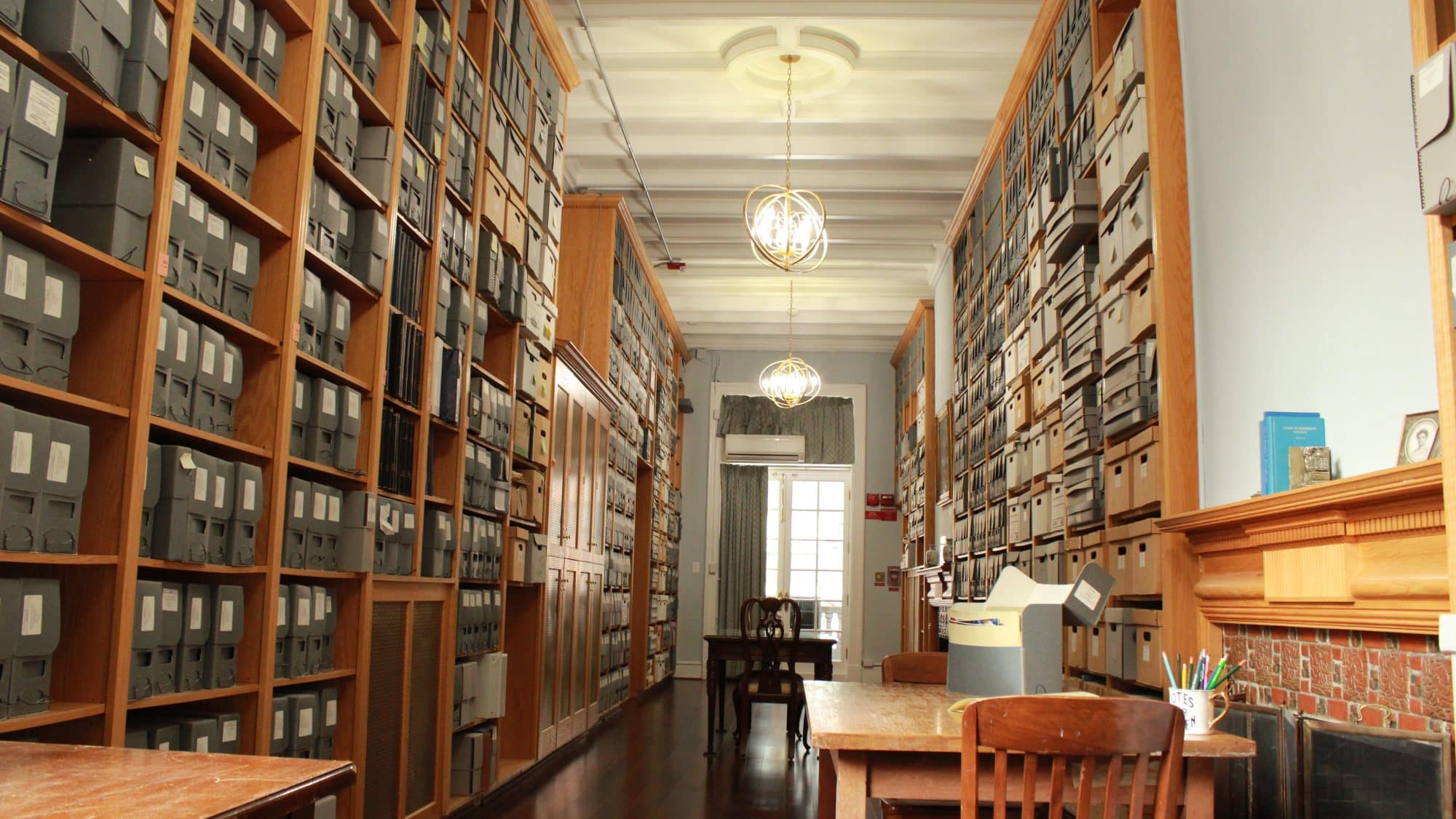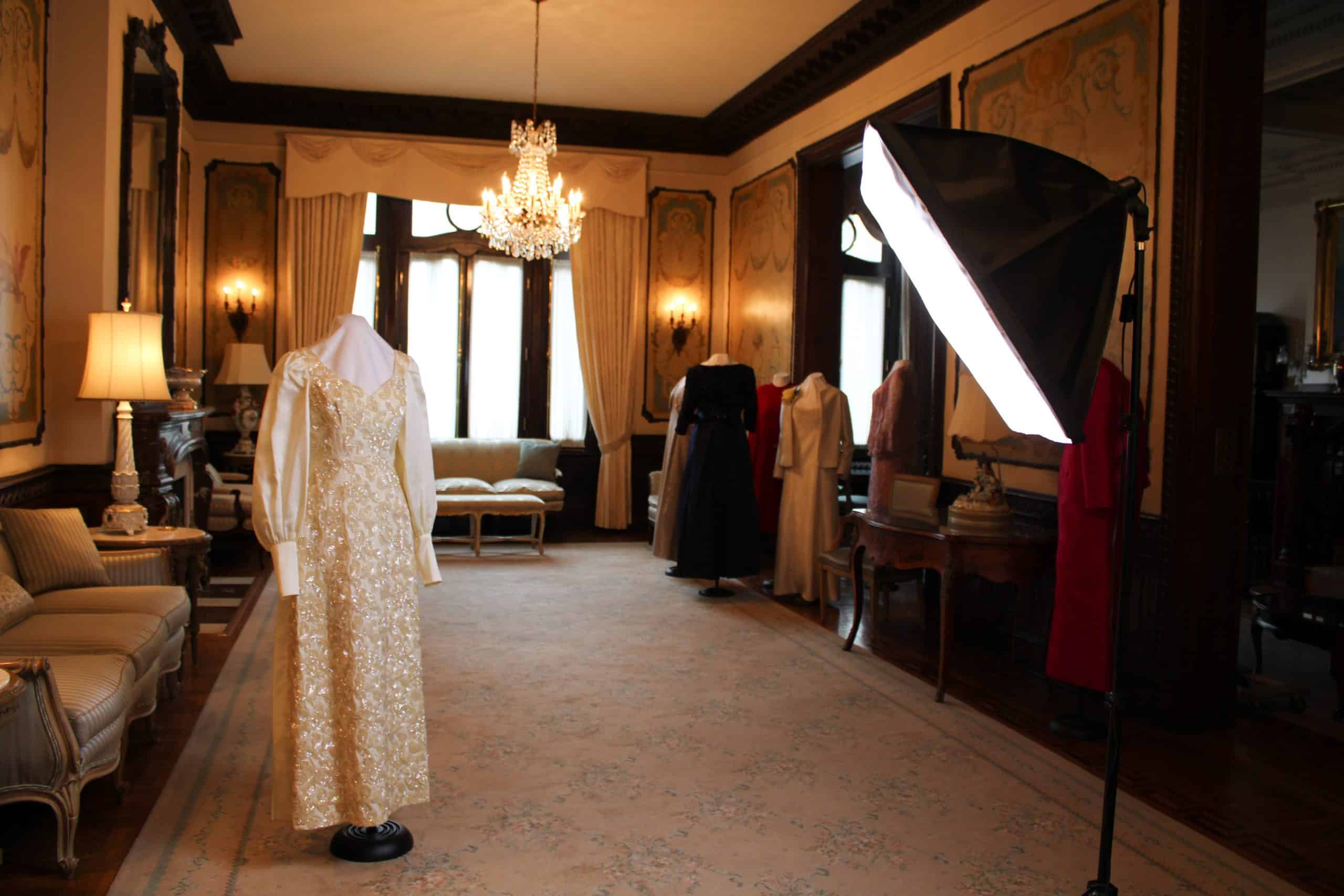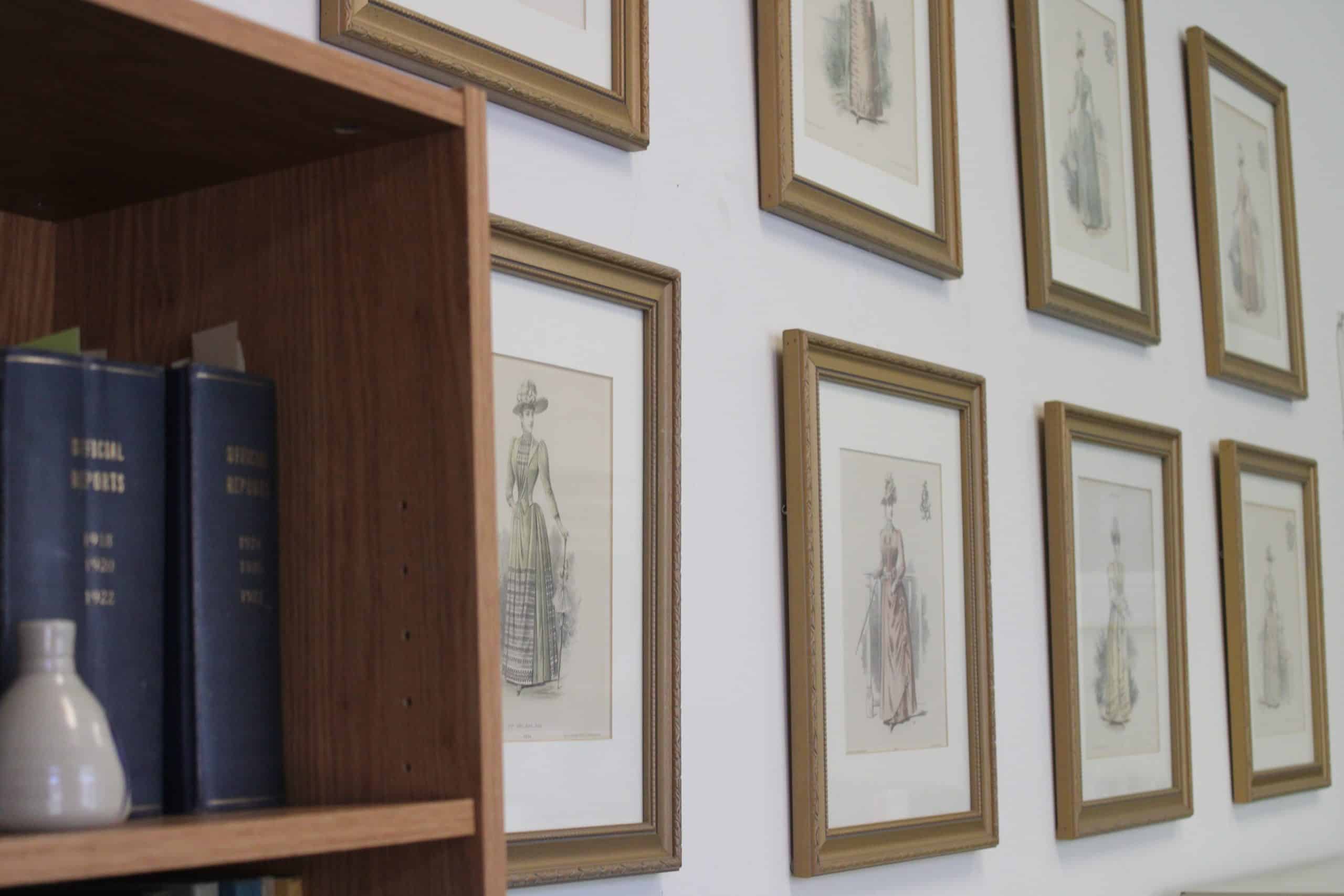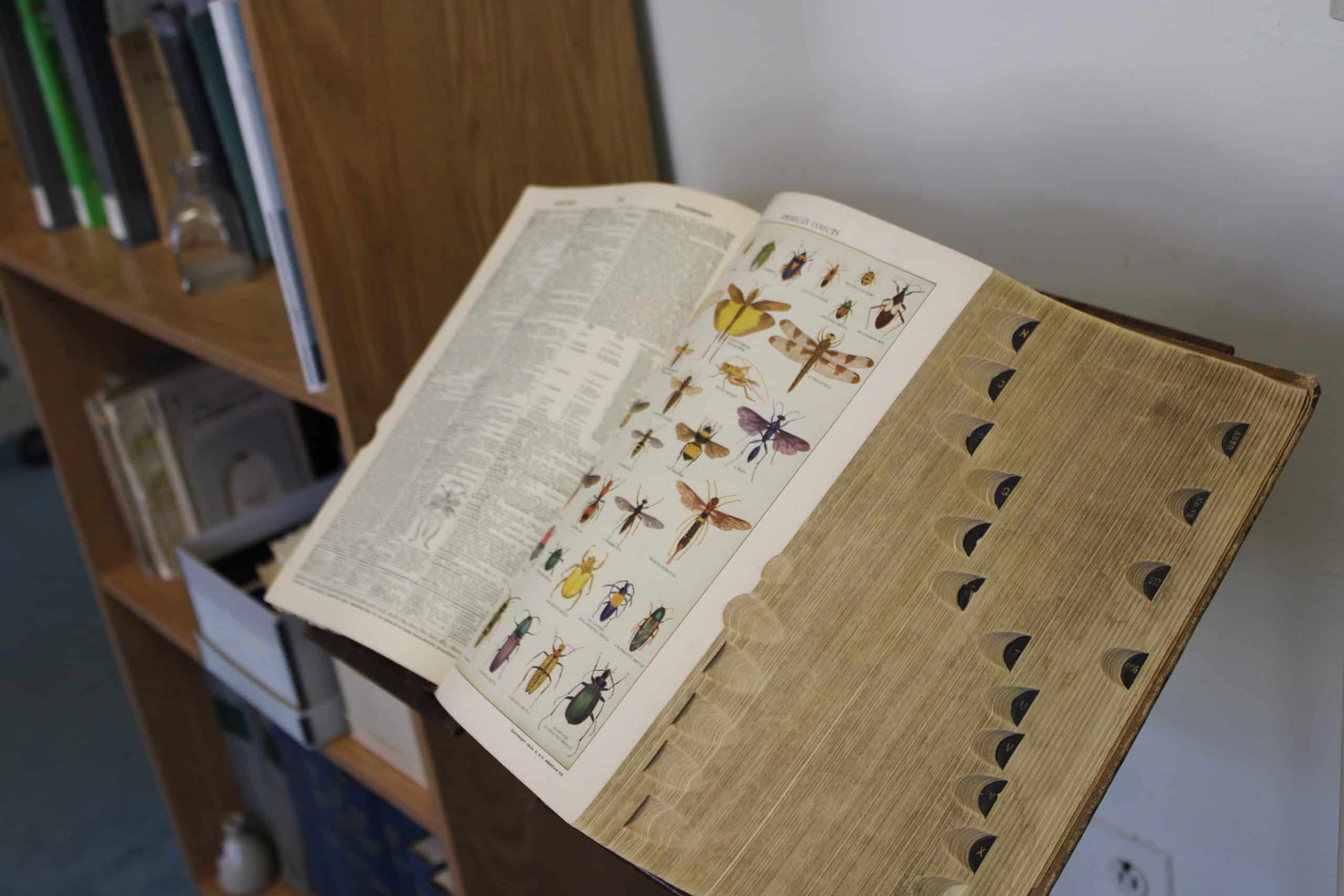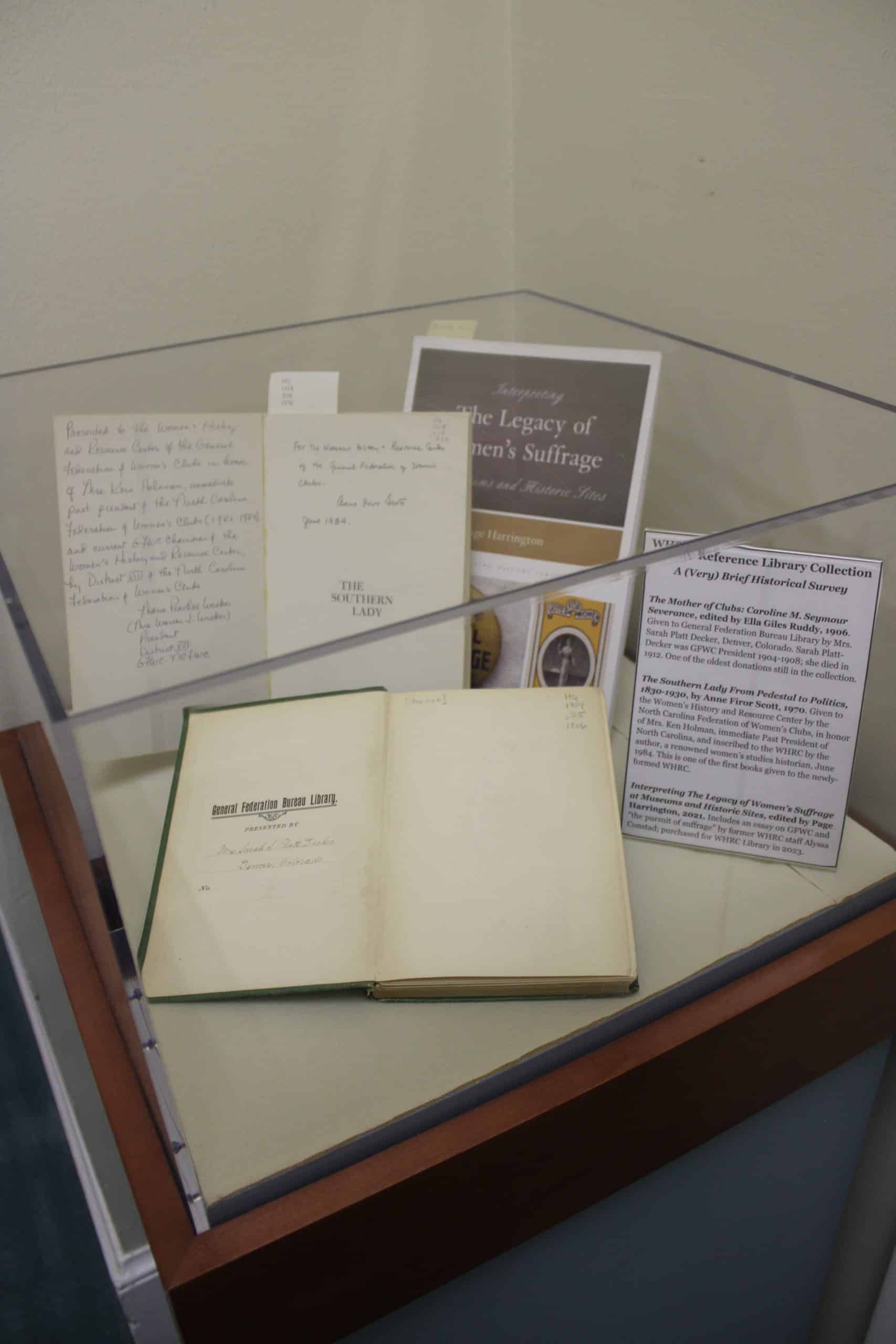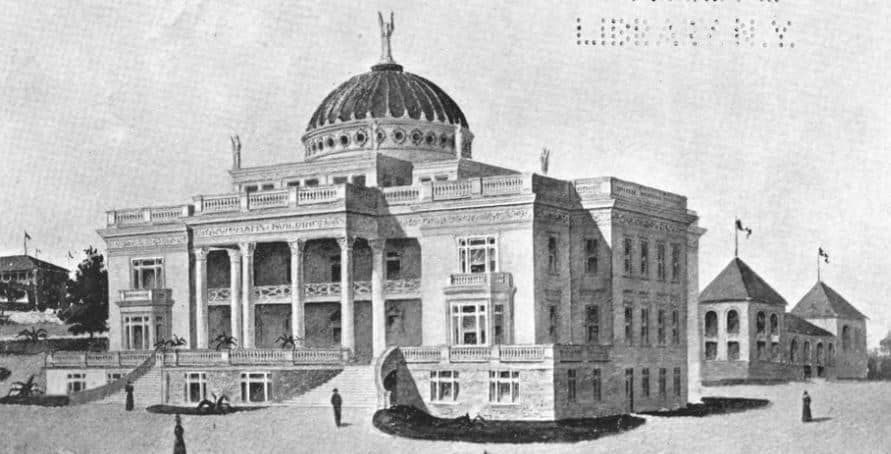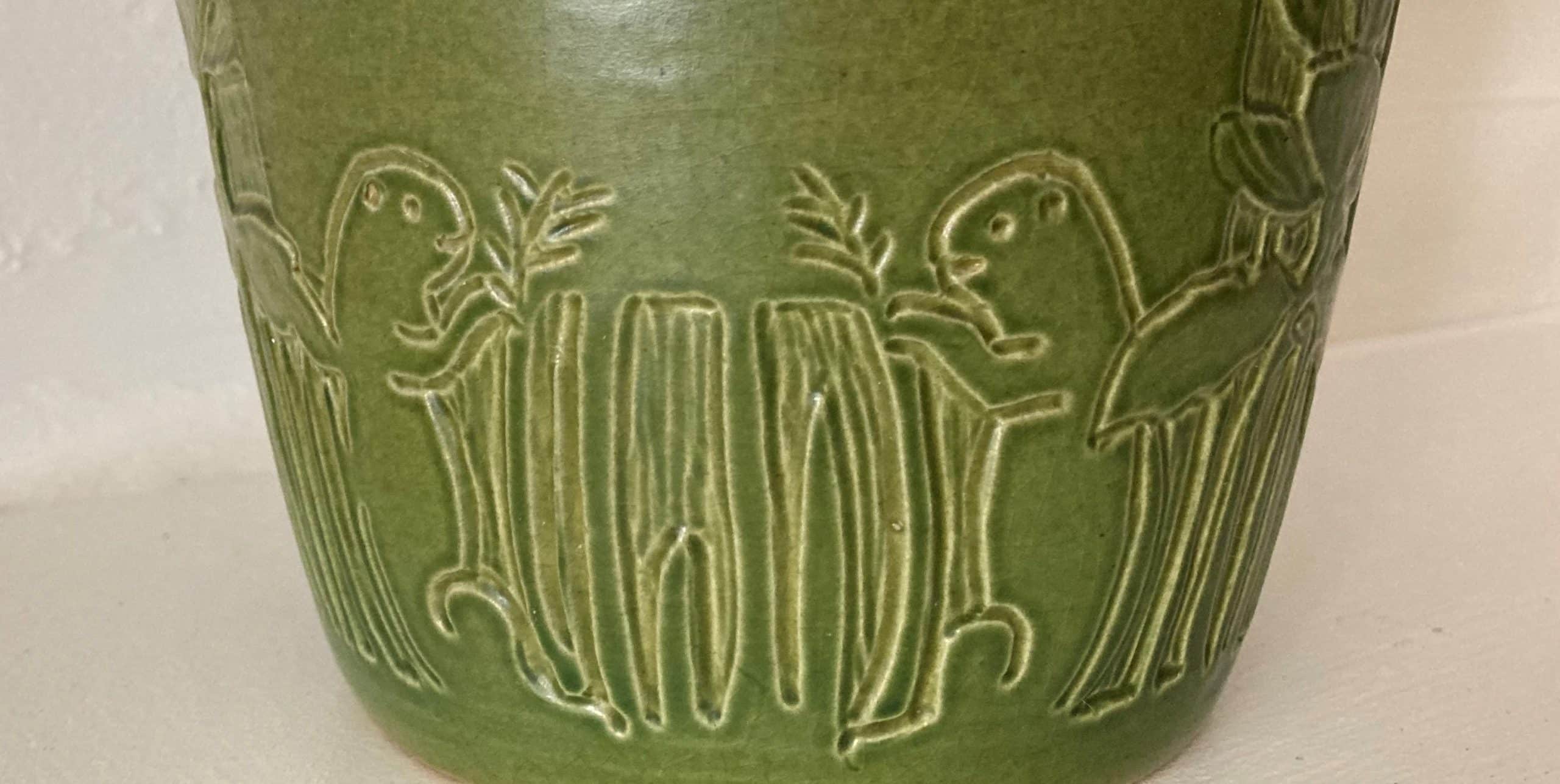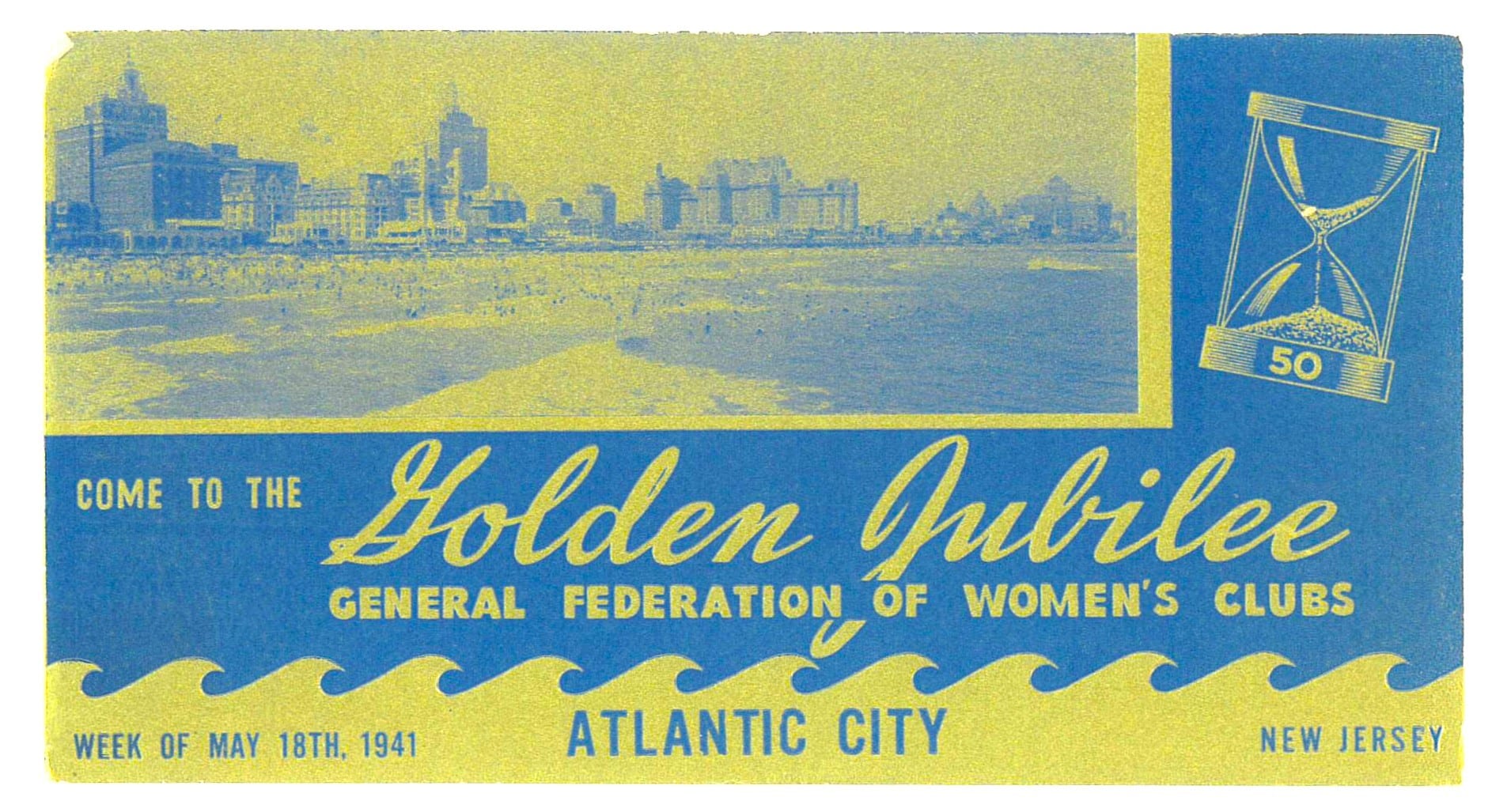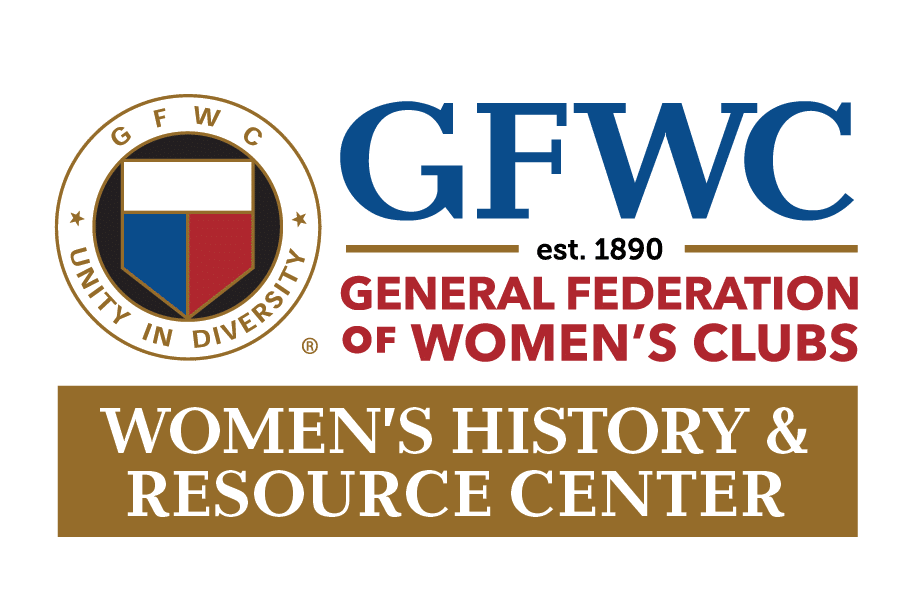
Founded in 1984, the GFWC Women’s History and Resource Center (WHRC) collects, preserves, interprets, and promotes the history of GFWC. The WHRC documents the social and political contributions of GFWC clubwomen from 1890 to the present through the GFWC archives and related special collections. Our holdings are available for research by clubwomen, academics, and the general public.
The WHRC collections encompass GFWC’s institutional archives, including convention records, files related to our programs and leadership, and “Clubwoman” magazine (and its predecessors). We hold a robust photograph and audio-visual collection, as well as GFWC ephemera, memorabilia, and the art and artifacts that furnish our historic Headquarters building. We also maintain a reference library collection focused on women’s history, the woman’s club movement, and the history of volunteerism.
Please note: While we do have many state- and club-level archival and photographic materials, we do not maintain official records for State Federations or local clubs, or for outside organizations.
WHRC: From the Archives
GFWC in Atlanta, 130 Years Ago As of this blog’s posting, we are just days away from opening the Gen…
WHRC: From the Archives
Looking at the Details One of the more delightful aspects of GFWC Headquarters (if you ask me) is th…
WHRC: From the Archives
Everybody Loves a Birthday Party The General Federation of Women’s Clubs, founded on April 24,…
Research at the WHRC
Learn more about the collections, request research assistance, or make an appointment to visit in person. To inquire about a potential donation, please email us with details: whrc@gfwc.org
LEARN MOREGFWC staff are in Atlanta for the 2025 Annual Convention, and your WHRC Librarian took the opportunity to visit Wimbish House, the historic home of the Atlanta Woman’s Club. I’m always ready to visit a clubhouse! #clubwomeninaction #clubwomeninhistory

GFWC staff are in Atlanta for the 2025 Annual Convention, and your WHRC Librarian took the opportunity to visit Wimbish House, the historic home of the Atlanta Woman’s Club. I’m always ready to visit a clubhouse! #clubwomeninaction #clubwomeninhistory
Since this is National Garden Week, the First Friday Featured Club for June is the Civic Garden Club of Denver!
The club was founded in early 1933, proudly belonging to both GFWC and the Colorado Federation of Garden Clubs. In May 1933, shortly after joining our Federation, they planted a Blue Spruce on the grounds of the state capitol in honor of GFWC President Grace Morrison Poole. The double photo they donated to GFWC Headquarters, shown here, pictures the smiling members next to a tightly cropped image of the tree.
The club history in our files tells us that the club was founded by Lisbeth Glatfelter Fish (1869-1955), a prominent woman in Denver who started several clubs. I`m not sure if she`s shown here, but she`s probably the person who donated the photograph to us; she also gave us two books of Colorado poetry around the same time. Sadly, the club appears to have ceased operations around 2000.
#clubwomeninhistory #nationalgardenweek #coloradohistory

Since this is National Garden Week, the First Friday Featured Club for June is the Civic Garden Club of Denver!
The club was founded in early 1933, proudly belonging to both GFWC and the Colorado Federation of Garden Clubs. In May 1933, shortly after joining our Federation, they planted a Blue Spruce on the grounds of the state capitol in honor of GFWC President Grace Morrison Poole. The double photo they donated to GFWC Headquarters, shown here, pictures the smiling members next to a tightly cropped image of the tree.
The club history in our files tells us that the club was founded by Lisbeth Glatfelter Fish (1869-1955), a prominent woman in Denver who started several clubs. I`m not sure if she`s shown here, but she`s probably the person who donated the photograph to us; she also gave us two books of Colorado poetry around the same time. Sadly, the club appears to have ceased operations around 2000.
#clubwomeninhistory #nationalgardenweek #coloradohistory
As many of our members are getting ready for the annual GFWC Convention, happening at the end of next week in Atlanta, Georgia, let`s take a look at one of my favorite convention-related items in the WHRC collection: this 14" long delegate ribbon from 1952.
A 5" diameter red crepe paper carnation (now sadly squashed), affixed to a paper doily, tops a 9" white paper ribbon printed boldly with "INDIANA." But why?? The ribbon makes more sense when you know that Mildred Ahlgren of Indiana was elected GFWC`s International President at that 1952 convention, and the delegates from Ahlgren`s home state were given strict instructions on how best to champion their candidate throughout the event. They were to mingle amongst other state federations, "APPLAUD" after Ahlgren`s speech, "help Indiana sing" at various events, "be dignified at all times," campaign wherever they could (though not, of course, in the convention hall itself!), and most importantly, "wear your Indiana badge at all times. Even with evening clothes." Seems like it worked (though I wonder if there were grumbles about combining "be dignified" and "wear your ribbon.")
…So if you`re attending the 2025 convention and thinking about your wardrobe, be glad you don`t have to coordinate it with an enormous paper corsage!
🌺 Indiana delegate ribbon, GFWC Convention, 1952. Gift of Mildred Carlson Ahlgren. Memorabilia collection, 1952.5.1
#clubwomeninhistory #GFWCconventionhistory
#indianahistory

As many of our members are getting ready for the annual GFWC Convention, happening at the end of next week in Atlanta, Georgia, let`s take a look at one of my favorite convention-related items in the WHRC collection: this 14" long delegate ribbon from 1952.
A 5" diameter red crepe paper carnation (now sadly squashed), affixed to a paper doily, tops a 9" white paper ribbon printed boldly with "INDIANA." But why?? The ribbon makes more sense when you know that Mildred Ahlgren of Indiana was elected GFWC`s International President at that 1952 convention, and the delegates from Ahlgren`s home state were given strict instructions on how best to champion their candidate throughout the event. They were to mingle amongst other state federations, "APPLAUD" after Ahlgren`s speech, "help Indiana sing" at various events, "be dignified at all times," campaign wherever they could (though not, of course, in the convention hall itself!), and most importantly, "wear your Indiana badge at all times. Even with evening clothes." Seems like it worked (though I wonder if there were grumbles about combining "be dignified" and "wear your ribbon.")
…So if you`re attending the 2025 convention and thinking about your wardrobe, be glad you don`t have to coordinate it with an enormous paper corsage!
🌺 Indiana delegate ribbon, GFWC Convention, 1952. Gift of Mildred Carlson Ahlgren. Memorabilia collection, 1952.5.1
#clubwomeninhistory #GFWCconventionhistory
#indianahistory
Did you know that May is National Inventors Month? Patents are one of your WHRC Librarian`s favorite avenues of artifact research (they explain things so thoroughly!) and are also a fantastic way to get at the often-overlooked history of women inventors. But it can help to have a starting place….
…Enter the editor of GFWC`s magazine! In the March 1914 issue, she published a list of recent patents awarded to women. The innovations noted here include improvements for the home and wardrobe, perhaps the expected purview of women inventors… but also industrial, commercial, and agricultural equipment.
📷 Grace G. Drayton of New York, New York: Design for a Bunny-Doll, November 18, 1913. "A new, original, and ornamental design." (Drayton is best known today for her illustrations of the Campbell Soup Kids.)
📷 Amelia I. Rooney of Pittsburgh, Pennsylvania: Shoe-polishing Box, November 25, 1913. "One object of this invention is to provide a serviceable foot support… so that all portions of the shoe are accessible for cleaning and polishing" while also providing a "convenient receptacle for brushes, polishes, etc." and "a means for holding it in position relatively to a chair occupied by the user."
📷 Dorothy Dyrenforth ("now by marriage Dorothy D. Auracher") of Oak Park, Illinois: Swimming-suit, November 4, 1913. "An improvement in swimming-suits for women`s wear" with a built-in brassiere.
📷 Jane E. Gillespie of Atlanta, Georgia: Water Heater, November 4, 1913. "A novel, convenient, and effective heating apparatus for domestic purposes" i.e. heating bath water and flat irons, "that may be readily taken from room to room."
📷 "Patents Granted to Women," March 1914 issue of "General Federation Magazine"
What`s your favorite invention by a woman? Have you, or anyone in your family, ever been granted a patent? Let us know in the comments!
#womenshistoryisamericanhistory #nationalinventorsmonth

Did you know that May is National Inventors Month? Patents are one of your WHRC Librarian`s favorite avenues of artifact research (they explain things so thoroughly!) and are also a fantastic way to get at the often-overlooked history of women inventors. But it can help to have a starting place….
…Enter the editor of GFWC`s magazine! In the March 1914 issue, she published a list of recent patents awarded to women. The innovations noted here include improvements for the home and wardrobe, perhaps the expected purview of women inventors… but also industrial, commercial, and agricultural equipment.
📷 Grace G. Drayton of New York, New York: Design for a Bunny-Doll, November 18, 1913. "A new, original, and ornamental design." (Drayton is best known today for her illustrations of the Campbell Soup Kids.)
📷 Amelia I. Rooney of Pittsburgh, Pennsylvania: Shoe-polishing Box, November 25, 1913. "One object of this invention is to provide a serviceable foot support… so that all portions of the shoe are accessible for cleaning and polishing" while also providing a "convenient receptacle for brushes, polishes, etc." and "a means for holding it in position relatively to a chair occupied by the user."
📷 Dorothy Dyrenforth ("now by marriage Dorothy D. Auracher") of Oak Park, Illinois: Swimming-suit, November 4, 1913. "An improvement in swimming-suits for women`s wear" with a built-in brassiere.
📷 Jane E. Gillespie of Atlanta, Georgia: Water Heater, November 4, 1913. "A novel, convenient, and effective heating apparatus for domestic purposes" i.e. heating bath water and flat irons, "that may be readily taken from room to room."
📷 "Patents Granted to Women," March 1914 issue of "General Federation Magazine"
What`s your favorite invention by a woman? Have you, or anyone in your family, ever been granted a patent? Let us know in the comments!
#womenshistoryisamericanhistory #nationalinventorsmonth
Good news: today is National Classic Movie Day! By whose authority? We`re not sure, but any opportunity to watch an old movie is a welcome one. Need a recommendation? Clara B. Edwards, long-time GFWC Motion Picture Division Chairman, might suggest "Born Yesterday," one of her top picks for 1950 (and a personal favorite, so I`m happy to second her positive review).
In her work with GFWC, the National Council of Women, and the Federation of Motion Picture Councils, Edwards prepared guidance on how to both judge a good movie and write a substantive review. Edwards and her volunteer team – a "cross-section of American women" – used this method to review films based on various criteria, hone their skills as writers and, not incidentally, let their fellow clubwomen know what to expect from the movies on offer at the local theater.
📗"Hand-Book for Previewers," by Mrs. Dean Gray Edwards, circa 1960. Programs collection.
("Born Yesterday" was one of the "Best Pictures of 1950" as relayed in Edwards` monthly movie review column, "GFWC Clubwoman," February 1951. The movie preview team also recommended "All About Eve," "Sunset Boulevard," and "Annie Get Your Gun," among others.)
#nationalclassicmovieday #clubwomeninhistory

Good news: today is National Classic Movie Day! By whose authority? We`re not sure, but any opportunity to watch an old movie is a welcome one. Need a recommendation? Clara B. Edwards, long-time GFWC Motion Picture Division Chairman, might suggest "Born Yesterday," one of her top picks for 1950 (and a personal favorite, so I`m happy to second her positive review).
In her work with GFWC, the National Council of Women, and the Federation of Motion Picture Councils, Edwards prepared guidance on how to both judge a good movie and write a substantive review. Edwards and her volunteer team – a "cross-section of American women" – used this method to review films based on various criteria, hone their skills as writers and, not incidentally, let their fellow clubwomen know what to expect from the movies on offer at the local theater.
📗"Hand-Book for Previewers," by Mrs. Dean Gray Edwards, circa 1960. Programs collection.
("Born Yesterday" was one of the "Best Pictures of 1950" as relayed in Edwards` monthly movie review column, "GFWC Clubwoman," February 1951. The movie preview team also recommended "All About Eve," "Sunset Boulevard," and "Annie Get Your Gun," among others.)
#nationalclassicmovieday #clubwomeninhistory
Today is National Teacher Day (and this is National Teacher Appreciation Week)! GFWC has been a long-time supporter of teachers, as demonstrated by this charming – though still quite serious – intro to a November 1956 article in our magazine. When preparing for today`s post, we found articles about supporting, training, and compensating teachers (turning "appreciation" into action!) in our magazines and program files as far back as the 1890s.
📷 "Let`s Give `Oscars` to Our Teachers," by Sara A. Whitehurst, Chairman, Department of Education, GFWC. "General Federation Clubwoman", November 1956
#clubwomeninaction #nationalteacherday

Today is National Teacher Day (and this is National Teacher Appreciation Week)! GFWC has been a long-time supporter of teachers, as demonstrated by this charming – though still quite serious – intro to a November 1956 article in our magazine. When preparing for today`s post, we found articles about supporting, training, and compensating teachers (turning "appreciation" into action!) in our magazines and program files as far back as the 1890s.
📷 "Let`s Give `Oscars` to Our Teachers," by Sara A. Whitehurst, Chairman, Department of Education, GFWC. "General Federation Clubwoman", November 1956
#clubwomeninaction #nationalteacherday
Today we’re launching a new monthly IG series, not-so-imaginatively titled First Friday Club Feature. (Maybe we’ll keep workshopping the title.) Every month we’ll highlight a GFWC member club with a photo or archival item from the GFWC Women’s History and Resource Center collection. Since we’re starting in May – Asian American and Pacific Islander Heritage Month! – we’ve chosen the GFWC AZ Desert Jade Woman’s Club (Tempe, Arizona).
Desert Jade was founded in 1960 by a group of young Chinese American women, prompted by Margie Sing who had belonged to a woman`s club in Los Angeles. Over the decades the club members have supported community work like the art museum, fire department, scholarships, and the veterans’ hospital. They’ve also worked to preserve and share their cultural heritage through projects like “Tea and Chopsticks,” their long-running cookbook series (first produced in 1966), and making and selling over 31,000 eggrolls between 1988 and 1990. Their book “Lotus Pod: A Collection of Cultural Memories” was written by club members in 1978, with a revised edition in 2004. The Preface to the 2004 edition talks about reaching out to the elders in the community for information to share with American-born children, concluding, “This is a precious heritage that should not be lost with time.”
📷Cover and title page of “Lotus Pod” (2004). From the WHRC Club History collection, CH AZ 020
Side note: WHRC would love to add a copy of “Tea and Chopsticks,” and a 1978 “Lotus Pod,” to the collection… just putting that out there! (We’d also love an eggroll right now, but we’ll have to source that ourselves.)
#clubwomeninaction #clubwomeninhistory #womenshistoryisamericanhistory
#livingthevolunteerspirit

Today we’re launching a new monthly IG series, not-so-imaginatively titled First Friday Club Feature. (Maybe we’ll keep workshopping the title.) Every month we’ll highlight a GFWC member club with a photo or archival item from the GFWC Women’s History and Resource Center collection. Since we’re starting in May – Asian American and Pacific Islander Heritage Month! – we’ve chosen the GFWC AZ Desert Jade Woman’s Club (Tempe, Arizona).
Desert Jade was founded in 1960 by a group of young Chinese American women, prompted by Margie Sing who had belonged to a woman`s club in Los Angeles. Over the decades the club members have supported community work like the art museum, fire department, scholarships, and the veterans’ hospital. They’ve also worked to preserve and share their cultural heritage through projects like “Tea and Chopsticks,” their long-running cookbook series (first produced in 1966), and making and selling over 31,000 eggrolls between 1988 and 1990. Their book “Lotus Pod: A Collection of Cultural Memories” was written by club members in 1978, with a revised edition in 2004. The Preface to the 2004 edition talks about reaching out to the elders in the community for information to share with American-born children, concluding, “This is a precious heritage that should not be lost with time.”
📷Cover and title page of “Lotus Pod” (2004). From the WHRC Club History collection, CH AZ 020
Side note: WHRC would love to add a copy of “Tea and Chopsticks,” and a 1978 “Lotus Pod,” to the collection… just putting that out there! (We’d also love an eggroll right now, but we’ll have to source that ourselves.)
#clubwomeninaction #clubwomeninhistory #womenshistoryisamericanhistory
#livingthevolunteerspirit
Today, Wednesday, April 30, is the final day to register for the 2025 GFWC Annual Convention. Though the historic headlines shown here are from previous years (and other cities), our message remains the same over the decades: we want you to Come to Convention!
📷Convention invitation headlines from "Clubwoman" Magazine in 1966, 1964, 1956, and 1950.
The 2025 Annual Convention will be in Atlanta, Georgia, June 6-9. To learn more, visit gfwc.org/annual-convention for details and a link to register. We hope we`ll see you there!
#LivingTheVolunteerSpirit #clubwomeninaction #gfwc2025ac

Today, Wednesday, April 30, is the final day to register for the 2025 GFWC Annual Convention. Though the historic headlines shown here are from previous years (and other cities), our message remains the same over the decades: we want you to Come to Convention!
📷Convention invitation headlines from "Clubwoman" Magazine in 1966, 1964, 1956, and 1950.
The 2025 Annual Convention will be in Atlanta, Georgia, June 6-9. To learn more, visit gfwc.org/annual-convention for details and a link to register. We hope we`ll see you there!
#LivingTheVolunteerSpirit #clubwomeninaction #gfwc2025ac
Happy Federation Day! On this day 135 years ago, the General Federation of Women`s Clubs was officially, well, Federated. Our Ratification Convention was held at Scottish Rite Hall in New York City, April 23-25, 1890, with delegates from 64 clubs in 18 states in attendance. The Constitution of the new organization was ratified on Thursday, April 24th, followed by election of officers the next day.
The Women`s History and Resource Center recently received a fantastic donation in the form of a bound volume of "The Woman`s Cycle," i.e., the very first interation of what we now call "Clubwoman" magazine. Though we had a few of these issues in the collection previously, this gift helps fill in a big gap in our early history, and includes several useful and new-to-us articles on the preparations for the April 1890 meeting. For example, thanks to an issue from March 1890, we learned that the ratification meeting was postponed "in consequence of delay in sending out drafts of the Constitution, and invitations, and conditions of membership, occasioned by the severity of a prevailing epidemic." [!] Apparently, Federation Day was originally planned for *March* 24th.
📜"A `Convention` Number," the Thursday, May 15, 1890 issue of "The Woman`s Cycle," edited by Jane Cunningham Croly (our founder, incidentally). At the time, the bi-monthly magazine was published for a wide variety of women`s organizations, not just now-federated clubs. Thus, the not-really-an-apology tone as the author (probably Croly herself) apologizes for letting the proceedings of the new Federation take over the entire issue.
From a bound volume of "The Woman`s Cycle" 1889-90, donated in memory of Jean Doreen Hager at the request of Donald Hager. 2025.007
#clubwomeninhistory
![Happy Federation Day! On this day 135 years ago, the General Federation of Women's Clubs was officially, well, Federated. Our Ratification Convention was held at Scottish Rite Hall in New York City, April 23-25, 1890, with delegates from 64 clubs in 18 states in attendance. The Constitution of the new organization was ratified on Thursday, April 24th, followed by election of officers the next day. The Women's History and Resource Center recently received a fantastic donation in the form of a bound volume of "The Woman's Cycle," i.e., the very first interation of what we now call "Clubwoman" magazine. Though we had a few of these issues in the collection previously, this gift helps fill in a big gap in our early history, and includes several useful and new-to-us articles on the preparations for the April 1890 meeting. For example, thanks to an issue from March 1890, we learned that the ratification meeting was postponed "in consequence of delay in sending out drafts of the Constitution, and invitations, and conditions of membership, occasioned by the severity of a prevailing epidemic." [!] Apparently, Federation Day was originally planned for *March* 24th. 📜"A 'Convention' Number," the Thursday, May 15, 1890 issue of "The Woman's Cycle," edited by Jane Cunningham Croly (our founder, incidentally). At the time, the bi-monthly magazine was published for a wide variety of women's organizations, not just now-federated clubs. Thus, the not-really-an-apology tone as the author (probably Croly herself) apologizes for letting the proceedings of the new Federation take over the entire issue. From a bound volume of "The Woman's Cycle" 1889-90, donated in memory of Jean Doreen Hager at the request of Donald Hager. 2025.007 #clubwomeninhistory](https://www.gfwc.org/wp-content/plugins/instagram-feed-pro/img/placeholder.png)
Happy Federation Day! On this day 135 years ago, the General Federation of Women`s Clubs was officially, well, Federated. Our Ratification Convention was held at Scottish Rite Hall in New York City, April 23-25, 1890, with delegates from 64 clubs in 18 states in attendance. The Constitution of the new organization was ratified on Thursday, April 24th, followed by election of officers the next day.
The Women`s History and Resource Center recently received a fantastic donation in the form of a bound volume of "The Woman`s Cycle," i.e., the very first interation of what we now call "Clubwoman" magazine. Though we had a few of these issues in the collection previously, this gift helps fill in a big gap in our early history, and includes several useful and new-to-us articles on the preparations for the April 1890 meeting. For example, thanks to an issue from March 1890, we learned that the ratification meeting was postponed "in consequence of delay in sending out drafts of the Constitution, and invitations, and conditions of membership, occasioned by the severity of a prevailing epidemic." [!] Apparently, Federation Day was originally planned for *March* 24th.
📜"A `Convention` Number," the Thursday, May 15, 1890 issue of "The Woman`s Cycle," edited by Jane Cunningham Croly (our founder, incidentally). At the time, the bi-monthly magazine was published for a wide variety of women`s organizations, not just now-federated clubs. Thus, the not-really-an-apology tone as the author (probably Croly herself) apologizes for letting the proceedings of the new Federation take over the entire issue.
From a bound volume of "The Woman`s Cycle" 1889-90, donated in memory of Jean Doreen Hager at the request of Donald Hager. 2025.007
#clubwomeninhistory
Happy Earth Day! This tranquil cover of the February/March 1990 "GFWC Clubwoman" was fitting for an issue focused on conservation, and on the ways in which GFWC club members could participate in environmental action.
Topics covered here included creating and maintaining wildlife preserves, community recycling initiatives, and environmental education as club programming, centered around "Earth Day 1990: A Turning Point for Saving Our Planet," by William K. Reilly, Administrator of the U.S. Environmental Protection Agency (1989-1993). Reilly concluded, "My hope is that this year`s celebration will help bring about a national commitment…. By thinking globally and acting locally, we can make a difference, one that will help preserve our environment for ourselves and the generations to come."
#earthday2025 #clubwomeninaction #livingthevolunteerspirit

Happy Earth Day! This tranquil cover of the February/March 1990 "GFWC Clubwoman" was fitting for an issue focused on conservation, and on the ways in which GFWC club members could participate in environmental action.
Topics covered here included creating and maintaining wildlife preserves, community recycling initiatives, and environmental education as club programming, centered around "Earth Day 1990: A Turning Point for Saving Our Planet," by William K. Reilly, Administrator of the U.S. Environmental Protection Agency (1989-1993). Reilly concluded, "My hope is that this year`s celebration will help bring about a national commitment…. By thinking globally and acting locally, we can make a difference, one that will help preserve our environment for ourselves and the generations to come."
#earthday2025 #clubwomeninaction #livingthevolunteerspirit
A few weeks ago, the GFWC Women’s History and Resource Center had an info table at the DC history Convention. It was wonderful to reach lots of potential researchers – but we heard too many times, “oh, but your archives must be only for members.” Not so! All are welcome in the WHRC: club members, students, academic researchers, and the general public. (By appointment only, though, please and thank you!) Do you, or someone you know, have a history research project that might intersect with GFWC’s 135 years of work on hundreds of causes? Let us know and we’ll be glad to help! #womenshistoryisamericanhistory

A few weeks ago, the GFWC Women’s History and Resource Center had an info table at the DC history Convention. It was wonderful to reach lots of potential researchers – but we heard too many times, “oh, but your archives must be only for members.” Not so! All are welcome in the WHRC: club members, students, academic researchers, and the general public. (By appointment only, though, please and thank you!) Do you, or someone you know, have a history research project that might intersect with GFWC’s 135 years of work on hundreds of causes? Let us know and we’ll be glad to help! #womenshistoryisamericanhistory
April is #NationalPoetryMonth, a perfect opportunity to highlight the GFWC poetry collection! This volume is one of my personal favorites, thanks to its cheerful cover, springtime content, and connection to the woman who is the reason we even have a GFWC poetry collection: Anita Browne (1894-1966), who served as our Chairman of Poetry in the early 1930s. During her term she collected regional poetry for the GFWC library, and held contests for poetic clubwomen.
Browne went on to work as Director of the National Poetry Center in New York City, and donated even more volumes of poetry to our library from the Center`s Poets Press. She also edited anthologies like this one, "The Year`s at the Spring: A Collection of Poems of the Earth" (1940), which featured a selection of nature-related poetry submitted by women and men from across the country.
#clubwomeninhistory #happyspringtime

April is #NationalPoetryMonth, a perfect opportunity to highlight the GFWC poetry collection! This volume is one of my personal favorites, thanks to its cheerful cover, springtime content, and connection to the woman who is the reason we even have a GFWC poetry collection: Anita Browne (1894-1966), who served as our Chairman of Poetry in the early 1930s. During her term she collected regional poetry for the GFWC library, and held contests for poetic clubwomen.
Browne went on to work as Director of the National Poetry Center in New York City, and donated even more volumes of poetry to our library from the Center`s Poets Press. She also edited anthologies like this one, "The Year`s at the Spring: A Collection of Poems of the Earth" (1940), which featured a selection of nature-related poetry submitted by women and men from across the country.
#clubwomeninhistory #happyspringtime
